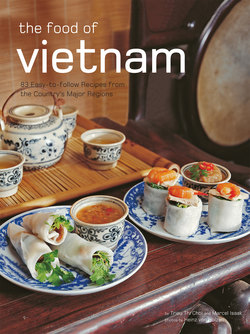Читать книгу Food of Vietnam - Trieu Thi Choi - Страница 7
На сайте Литреса книга снята с продажи.
ОглавлениеThe Ascending Dragon
Since the mid-1980s, a combination of economic upturn and the return of many overseas Vietnamese (encouraged by the government to start new businesses) has resulted in, among other things, the rebirth of a thriving restaurant scene—from flashy new establishments to informal sidewalk cafes lining the streets.
Culinary skills are being relearned, courses for the training of professional chefs are being launched and. most importantly. the Vietnamese are once again discovering the joys of cooking. Top-quality, fresh ingredients are widely available. Vietnam is fortunate in being able to grow a diverse variety of vegetables and fruits throughout the country, and little food is imported. Rice and seafood are once again in abundant supply.
Restaurants, which reflect this renewed interest in food, are as much about ambience—sipping a pastis or lingering over a bottle of fine French wine—as about the quality of food. Found all over Ho Chi Minh City and, to a slightly lesser extent, in Hanoi, these restaurants are often built around courtyards in French colonial buildings or designed to resemble old Vietnamese family homes. With their distinctly nostalgic feel, these new restaurants are not only redefining the Vietnamese aesthetic, but also serving food which is improving by the year. French restaurants are once again establishing themselves, and fashionable Italian restaurants are making an appearance, but the most interesting development is undoubtedly the new Vietnamese restaurants.
Modern Vietnamese cuisine is a marriage of the old and the new. Recipes from past generations coupled with new dishes created for the increasingly sophisticated and well-traveled local consumers. A good example is thit kho to, pork cooked slowly in a claypot, a dish of peasant origins which now appears on restaurant menus alongside cua rang me. an innovative fried crab dish, richly flavored with tamarind. The traditional Hanoi beef soup, pho, served with noodles, bean sprouts and fresh herbs, has gone through many transitions, but remains as tasty today as in the past.
The sometimes lengthy preparation times and cooking processes required by Vietnamese cuisine can render it something of a luxury for people with busy lives, so many chefs and teachers within Vietnam have begun experimenting with new methods that preserve the spirit of the cuisine, but allow it to be prepared quickly and simply at home. For example, deep-fried squid, which is traditionally made with minced squid combined with egg. wrapped in rice paper and then fried, is today being made with whole pieces of squid to save time. The Chinese influence is also being felt In fact, it is not unusual to find soy sauce on the table alongside nuoc mam in the newer restaurants.
Ironically, at the same time that this movement towards quicker cooking has been evolving, there has also been a resurgence of interest in the traditional dishes of the Hue court, the style of Vietnamese cooking that requires the longest preparation time of all. Restaurants specializing in this cuisine often cannot open until after lunch because of the considerable amount of time required to prepare the food, and often close early at night because the food has run out.
More and more attention is being paid to attractive presentation as well, although very few changes, if any, are made to cater to the tourist trade. The changes are subtle and often imperceptible: ga bop, a chicken salad flavored with onion, rau ram herb and a seasoning of salt, pepper and lime juice, has traditionally been made with chicken skin and bones, but new restaurants are preparing it with lean chicken meat instead. Some fat may also be removed from the meat in the pork and bamboo shoot dish mang ham chan goi, a move welcomed as much by health-conscious Vietnamese as by the increasing number of visitors.
The cuisine is based on rice, fish and fresh vegetables. Little oil is used in cooking, except for deep-frying and salads are lightly dressed. Healthy, cleansing soups such as the tasty canh chua thorn ca loc are featured on menus, fresh fruit and delicious homemade yogurt are often served for dessert, and drinks like freshly squeezed sugar cane juice are widely available. It seems likely that, as more cooks learn how to prepare it, and diners begin to understand and appreciate the flavors, Vietnamese food could become as popular as Chinese and Thai. France, Australia and the United States in particular, are already key centers for Vietnamese food. However, there is nothing like eating at a smart new restaurant in a converted French villa in Ho Chi Minh City.
Saigon's chic new eateries cater to a growing band of discerning diners.
